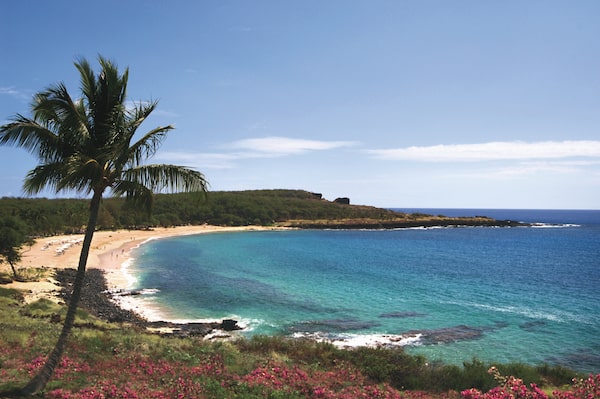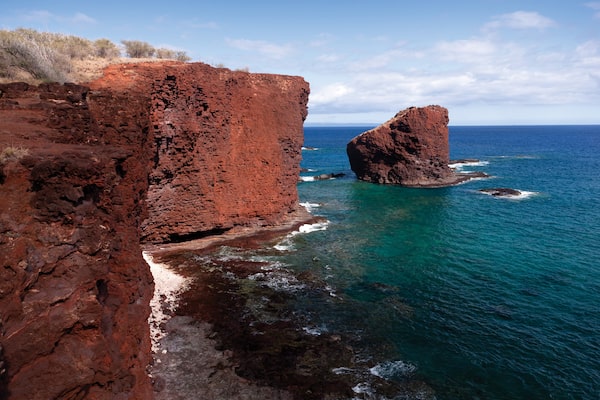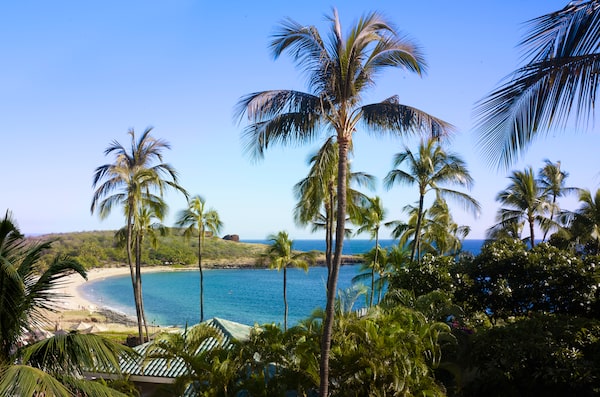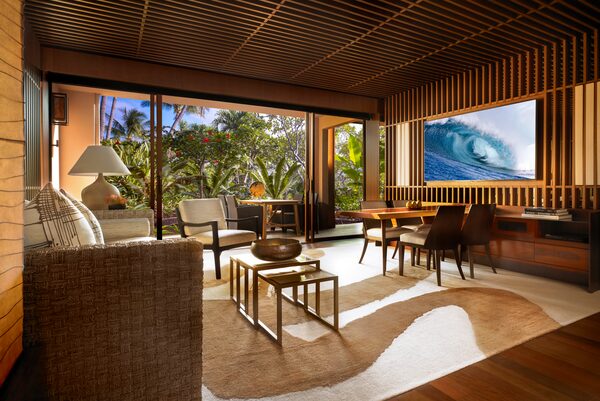
One of the beaches on the tiny island of Lanai.Peter Vitale,/Four Seasons
It’s a curious experience to watch a Hollywood movie while sitting on a pinprick of an island smack in the middle of the Pacific Ocean – yet this is just part of a typical day on Lanai of late. The Hale Keaka Lanai Theatre in Hawaii, commissioned in 1926 by pineapple magnate James Dole, once hummed when this wee 364-square-kilometre isle produced 75 per cent of the world’s pineapples. Behind its walls, live plays, musical acts and, later, movies all formed part of the fabric of Lanaians’ daily lives. Eventually, pineapple production moved elsewhere and the thriving art-deco theatre shuttered. After a long hiatus, however, this pint-sized film house has opened its doors again to play a starring role in Lanai’s next act.
In the past two decades, the private island of Lanai has become synonymous with luxe getaways, typically as a two-day splurge tacked on to a longer Maui stay. That’s all changing with recent investment in the island’s inhabitants and infrastructure thanks to its new owner, tech billionaire Larry Ellison. In addition to reopening the local theatre – its roughly US$4-million state-of-the-art renovation was four times more what Dole paid for the entire island in 1922 – Ellison has undertaken to fix the community swimming pool and a retrofit of the iconic Four Seasons Resort Lanai, all of which are aimed at capturing visitors’ attention for longer than a couple of days.
Right now, my attention is fully focused on the bull’s eye at the Lanai Archery and Clay Pigeon range. Despite the fact I’m suited up and have undergone an introductory lesson – and the target is only a few metres away – it’s evident I’ll never survive an apocalypse, let alone a Hunger Games film. My lack of skill puts me in the minority on Lanai. In a place where supplies need to be barged in, the overabundance of local deer means that roughly 80 per cent of its residents are at least occasional Robin Hoods who use their bows to stock their freezers with venison. The city slicker in me is impressed, if a little daunted, and I comfort myself that if archery doesn’t pan out, I can always learn to fly my own plane or play the surfside Jack Nicklaus golf course, both standard-issue activities for guests of the Four Seasons.

Puu Pehe (Sweetheart Rock).Don Riddle/Four Seasons

Hulopoe Bay.Barba/Four Seasons
On the return to the hotel, it’s smooth sailing thanks to a lack of traffic lights; with only 48 kilometres of paved road on the whole island, there’s hardly a need. That evening, while saddling up at the bar at Nobu – the famed Japanese restaurant is also a Lanai experience – I notice local grilled venison on the menu, where it’s joined by a bevy of local catch: big island lobster, seared Hawaiian snapper, steamed onaga, all part of what seems to be an island standard of a 10-mile diet.
The following day, my next adventure requires me to again suit up – or, rather, down – for the protective padding of the massage table. The Four Seasons’ newly anointed Hawanawana Spa figures heavily in the hotel’s best-or-nothing ethos. In here, the island’s roots are showcased with a massage featuring antioxidant-rich pineapple, honey and sugar, which leaves my skin tingly clean and redolent of the island’s most famed fruit.
While the draw of hotel’s low-key luxury threatens to keep me a willing hostage, there’s much more to pack in: shipwrecks, abandoned villages and deserted beaches, to name a few. I rent one of the hotel’s Jeeps, ditch the paved roads and set off to parts unknown.

A suite at the Four Seasons Resort Lanai.Barbara Kraft/Four Seasons

One of the island's many unpaved roads.Four Seasons
Past the Palawai Basin and onward to Kaunolu on the south shore, I park the car and cut a path down to the craggy beach. At a picnic table under the shade of a tree, I find three staff members from Lanai’s Department of Culture and Historic Preservation taking a lunch break from their work restoring a trail that leads to the former royal residence of King Kamehameha the Great. One of them plops his sandwich down, introduces himself as Ben, and offers to act as my guide for an impromptu tour that ends up lasting 45 minutes. He takes me through the sacred ruins of the former Kaunolu Village site, a fishing village dating back to the 1400s, and up to a 24-metre (80-feet) sea cliff jump called Kahekili’s Leap. It’s here that King Kamehameha’s warriors would prove their bravery by jumping over the precipitous edge to the water below.
As I drive away, I think about something Ben told me when I asked about living in a small community: “We’re all in the same canoe. What you do is going to affect everyone in that canoe,” he said. For the rest of my drive around the island – and, come to think of it, the drive to and from the resort – I rarely see another soul, local or tourist. Ben’s metaphor is apt: While many famed resorts bustle like cruise ships, Lanai is like a canoe – small, handcrafted, personal. That’s what sticks with me. For an island that’s steeped itself in superlatives, this one fact reigns supreme: You can have it all to yourself.